More young people are using e‑cigarettes/vapes
Electronic cigarettes/e‑cigarettes or vapes (referred to collectively as ‘e‑cigarettes’) are personal vaping devices where users inhale aerosol rather than smoke. The inhaled aerosol usually contains flavourings, a range of toxic chemicals, and may contain nicotine as well (Department of Health and Aged Care 2023).
E‑cigarette policy landscape in Australia
From early 2024, stronger controls on the importation, manufacture, advertising, supply and commercial possession of all e‑cigarette devices and components (with and without nicotine) are being implemented by the Australian Government. These regulatory changes are being implemented by the Federal Government in stages during 2024 in partnership with State and Territory Governments (TGA 2023).
The 2022–2023 NDSHS was conducted before these restrictions were put into place. At the time, in most jurisdictions, it was legal for adults to purchase e‑cigarettes that did not contain nicotine from a broad range of retail settings, including those used to purchase tobacco products. Prior to 2024, adults could also import nicotine e‑cigarettes with a prescription via the personal importation scheme.
These results reflect the prevalence of e‑cigarette use in Australia prior to the new restrictions coming into effect in 2024.
In 2022–2023, around half (49%) of people aged 18 to 24 in Australia reported having used an e‑cigarette at least once in their lifetime, the highest of all age groups. This was almost double the 26% of people who had done so in 2019 (Figure 1).
People aged 25 to 29 were the next most likely to have used e‑cigarettes in their lifetime, with 41% having done so (double the proportion who had done so in 2019).
In 2019, only 9.6% of people aged 14 to 17 in Australia had ever used e‑cigarettes; this percentage had nearly tripled by 2022–2023, to 28%.
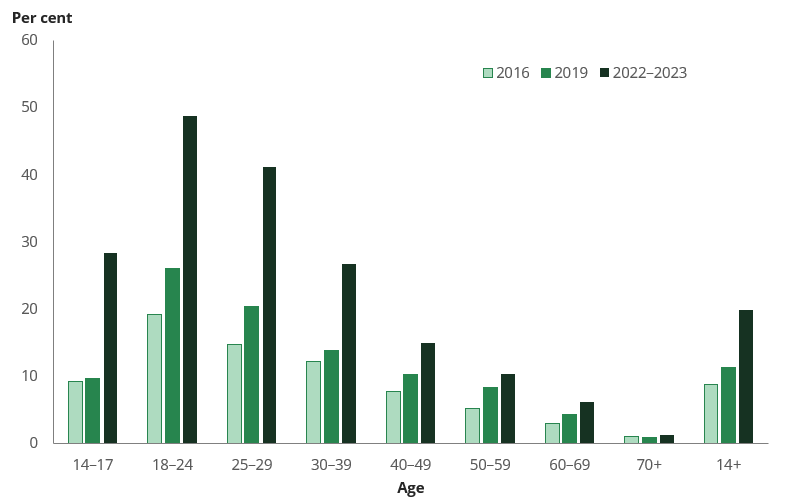
Source: NDSHS 2022–2023, Table 3.1.
The trends for people who were currently using e‑cigarettes showed a similar pattern across age groups. In 2022–2023, people aged 18 to 24 were the most likely to currently use e‑cigarettes at 21%, a four-fold increase since 2019 (5.3%) (Figure 2).
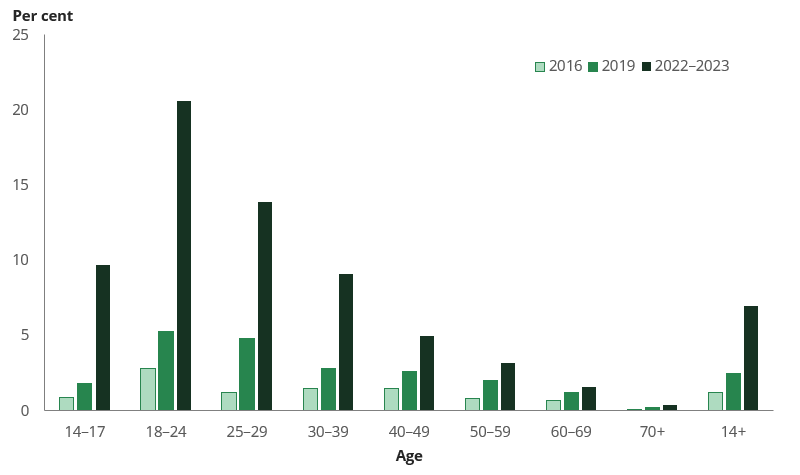
Note: Current use includes people using e‑cigarettes daily, at least weekly, at least monthly, or less often than monthly.
Source: NDSHS 2022–2023, Table 3.3.
Are young people using nicotine e‑cigarettes?
In general, there was little difference in the use of nicotine-containing e‑cigarettes between young people and the whole population. Over half (55%) of people aged 14 to 17 who had ever used e‑cigarettes reported that the one they last used contained nicotine in 2022–2023. The story was similar for people aged 18 to 24 (56%). The proportions in both these age groups were comparable to all people who had ever used e‑cigarettes aged 14 and over (54%).
People aged 14 to 17 were more likely than other age groups to report that they did not know whether their last used e‑cigarette contained nicotine. On average, 29% of people aged 14 to 17 who ever used e‑cigarettes didn’t know whether the last one they used contained nicotine; for the whole population who ever used e‑cigarettes, the proportion was 25%.
Females aged 14 to 17 were more likely to have most recently used an e‑cigarette containing nicotine than males in the same age group. In 2022–2023, among females aged 14 to 17 who had ever used an e‑cigarette, 62% stated that their last used e‑cigarette contained nicotine, while 25% were unsure. For males aged 14 to 17 who had ever used an e‑cigarette, only 49% reported that their last used e‑cigarette contained nicotine, but 35% were unsure whether it did or not.
In 2022–2023, among people whose last used e‑cigarettes containing nicotine, 87% reported that they obtained the nicotine e‑cigarette without a prescription. This was similar for people aged 14 to 17 (87%) and 18 to 24 (91%).
Are young people struggling to control their e‑cigarette use?
Overall, young people were less likely to report being unable to control their e‑cigarette use than the rest of the Australian population.
In 2022–2023, among all people who were currently using e‑cigarettes, 29% reported that they couldn’t stop or cut down on their use of e‑cigarettes, even though they wanted to or tried to. Among young people, the proportions were similar: 31% for people aged 14 to 17, and 32% for people aged 18 to 24.
People who had used e‑cigarettes in the past 30 days reported that they used them on an average of 15 days during the past 30 days. People aged 14 to 17 had used them 13 days on average during the past 30 days, while people aged 18 to 24 had done so an average of 14 days.
Almost 1 in 4 (23%) people aged 14 to 17 who were currently using e‑cigarettes reported that they used e‑cigarettes every day during the past 30 days. For people aged 18 to 24, it was similar (26%). These proportions were lower than other age groups (Figure 3).
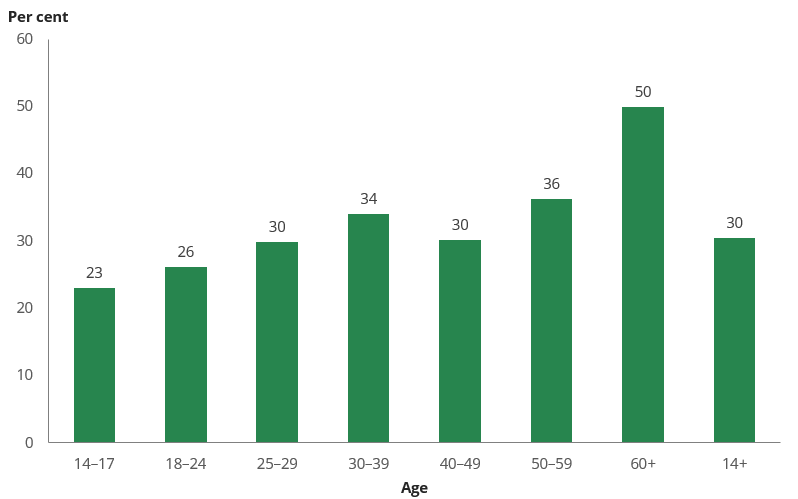
Note: Data are limited to people who used an e-cigarette in the previous 30 days.
Source: NDSHS 2022–2023, Table 3.22.
Why are young people using e‑cigarettes?
Results from the National Drug Strategy Household Survey do not provide evidence for or against the use of e-cigarettes as a smoking cessation tool, or as a gateway to tobacco smoking. The age groups most likely to smoke tobacco in 2019 and 2022–2023 were the least likely to use e-cigarettes, and the age groups most likely to use e-cigarettes had low tobacco smoking rates in 2019 and 2022–2023.
In most cases, the reason young people reported using e‑cigarettes was not because of a pre-existing relationship with tobacco smoking. The most common reason young people gave for ever using e‑cigarettes was out of curiosity (70%). Meanwhile, only 8.5% of people aged 15 to 24 who ever used e‑cigarettes said it was to help them quit smoking, much lower than the 21% of the total population. For people aged 15 to 24, the next most common reasons were all related to the perception that e‑cigarettes were better than regular (combustible) cigarettes (Figure 4).
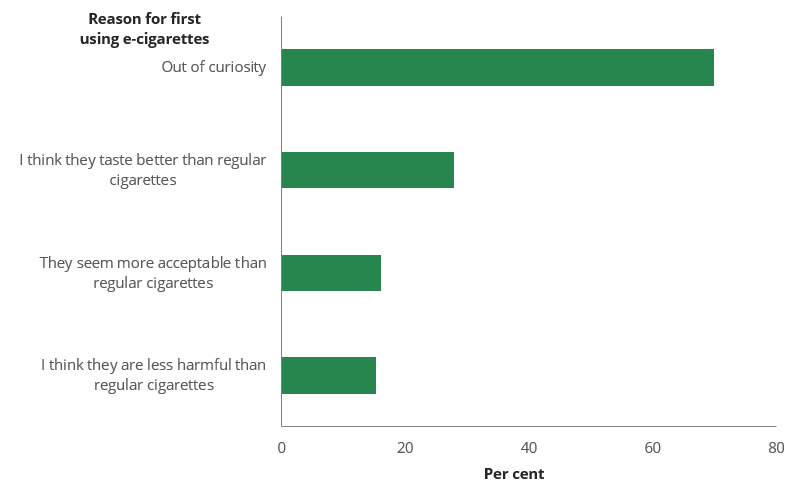
Notes:
1. Data are limited to people aged 15 to 24 and who had ever used an e‑cigarette.
2. Respondents could select more than one response.
Source: NDSHS 2022–2023, Table 3.34.
There has been a substantial rise in the proportion young people currently using e‑cigarettes but not smoking regular cigarettes. Among people aged 15 to 24 in Australia, 13.3% were currently using e‑cigarettes but not smoking regular cigarettes in 2022–2023, a sixfold increase since 2019 when just 2.3% used e‑cigarettes but did not smoke regular cigarettes (Figure 5).
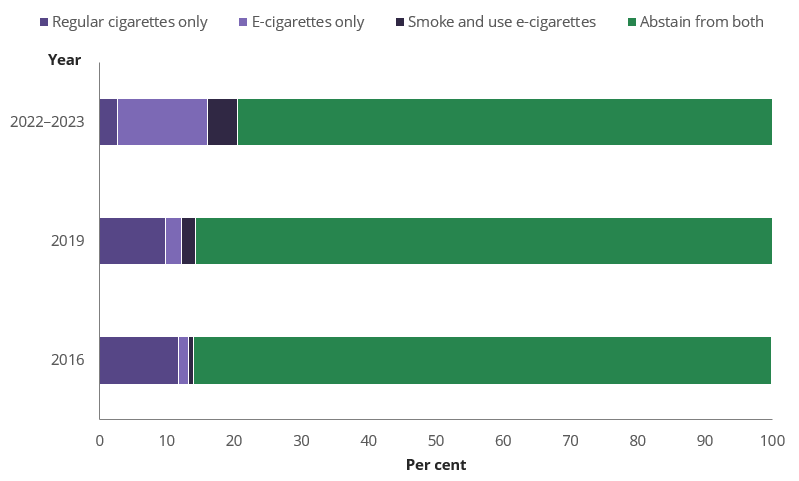
Source: NDSHS 2022–2023, Table 3.42.
Over half (57%) of people aged 15 to 24 who had ever used e‑cigarettes said that they usually obtained them from a “friend or family member”.
Young people’s support for e‑cigarette policies high, but lower than older people
The 2022–2023 National Drug Strategy Household Survey had a series of questions regarding policy measures designed to address e‑cigarette use. Support increased for all e‑cigarette policy options among the total population:
- Banning all additives in e‑cigarettes, to make them less attractive to young people: 78%, asked for the first time in 2022–2023.
- Restricting the use of e‑cigarettes in public places: 80%, an increase from 69% in 2019.
- Prohibiting the sale of e‑cigarettes, including those without nicotine, to people under 18 years of age: 86%, an increase from 79% in 2019.
- Strengthening restrictions on the advertising and promotion of e‑cigarettes: 82%, an increase from 67% in 2019.
People across the different age groups expressed different levels of support towards these measures.
Overall, people aged 60 and over expressed the highest levels of support for the four policy measures, with rates exceeding 85% for each measure. In contrast, people aged 14 to 29 showed the lowest rates of support, with support for all measures ranging between 60% and 80% (Figure 6).
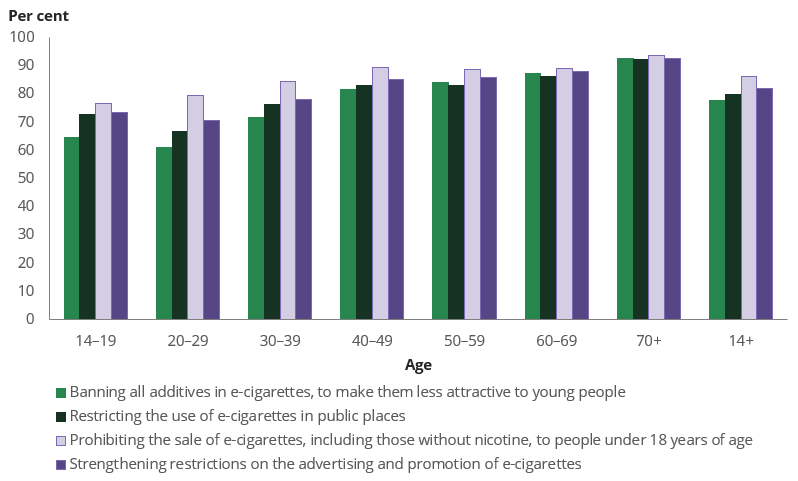
Source: NDSHS 2022–2023, Table 3.45.


